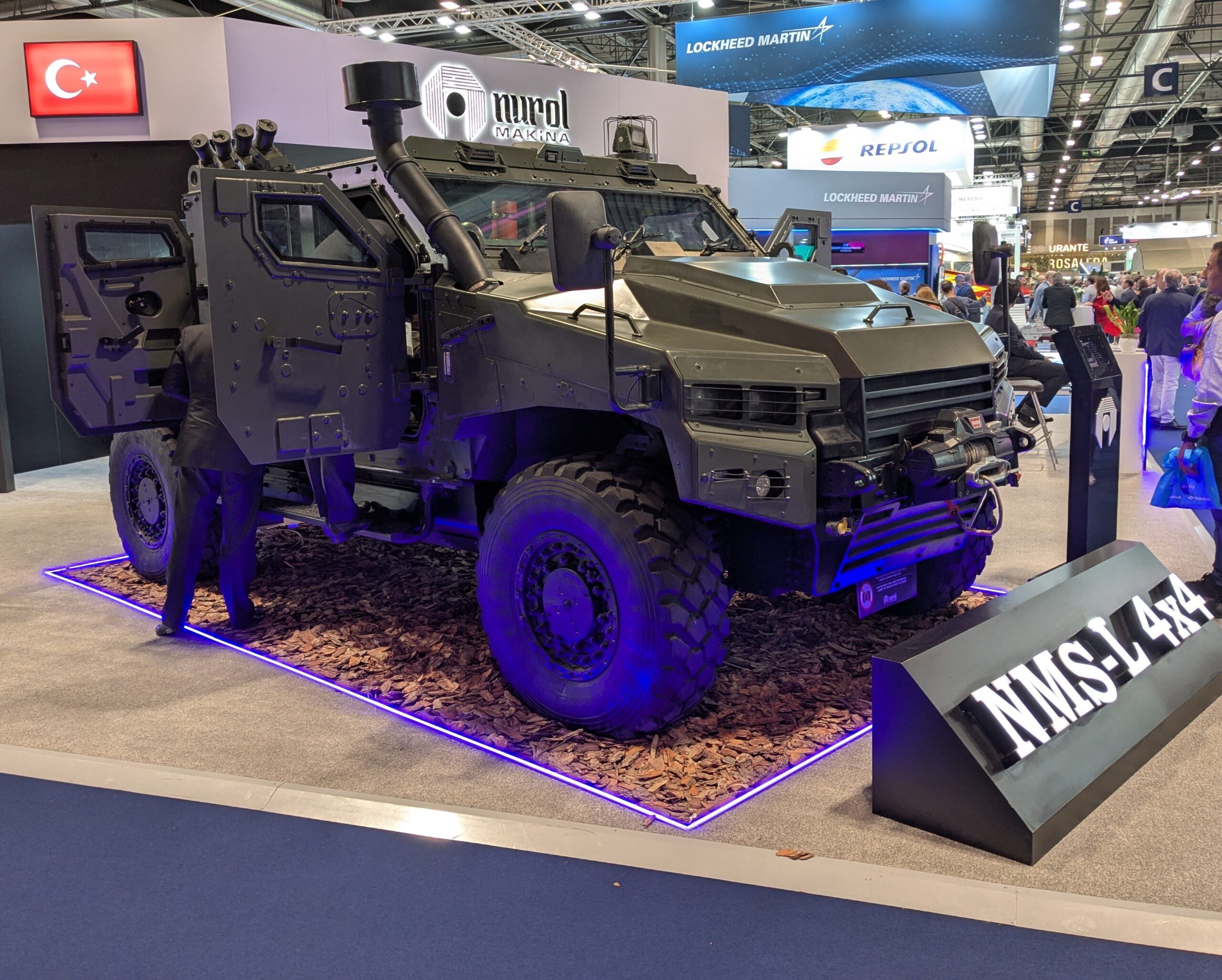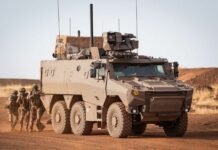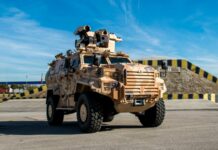Turkish armoured vehicle manufacturer Nurol Makina is working to make a success of exploiting a relatively narrow segment of the wheeled armoured vehicle market to offer its customers effective yet affordable protected mobility solutions.
The company’s offerings focus on the protected 4×4 vehicle market, with its range including the 18-tonne Ejder Yalçin tactical armoured vehicle, the 13-tonne NMS and 10-tonne NMS-L protected mobility vehicles, the 13-tonne PARS tactical light armoured vehicle in co-operation with Turkey’s FNSS, the 8.8-tonne Ilgaz II armoured vehicle, the Ejder Kunter special-purpose platform/armoured personnel carrier and a riot control vehicle called the Ejder Toma. The company has supplied thousands of armoured vehicles to around 20 different countries.
Nurol Makina exploits that 4×4 range to deliver customer solutions that avoid ground-up development costs, delivering effective solutions in the shortest possible time frames, and derives almost 90% of its revenue from export orders.
Speaking at the FEINDEF 2025 defence exhibition in Madrid on 13 May, James de St John-Pryce, business development director for the UK arm of the company (NMSUK), told ESD, “We have a very narrow focus in the defence industry in terms of land platforms. It’s a very niche segment, but we serve a wide range of end users geographically.
“Designing a vehicle for only one specific mission for only one specific customer is too expensive. When you look at our history, we generally develop a new vehicle every three to four years, and we constantly improve it with the feedback coming from operational environments,” said St John-Pryce.
“When a customer comes to our vehicle asking for some changes, we never say, ‘Oh no, we can’t do that; that is too expensive.’ We say, ‘OK, we’ll listen to you; let’s see if we can do it.’ If we can’t, we say, ‘I understand your needs, but how about if you solve it this way or that way?’ So we always find the solution to the requirements.
“I think that’s the key differentiator when it comes to 4×4 armoured vehicles,” said St John-Pryce. “If you go and check all 4×4 vehicles in this show, probably there are two or three engine manufacturers and transmission manufacturers, so you cannot say ‘I have a better engine that nobody has.’ So the thing is how you handle the project, how you treat your customers, to give them high quality on time. That’s the sustainability issue, I think, for the business.”
Emre Akin, Nurol Makina’s strategic planning and market development director, told ESD at FEINDEF 2025, “It was our strategic target to become an international organisation six or seven years ago, so we established our Hungarian company and factory five years ago. We are about to start manufacturing operations in Hungary for our long-term programme, so we have a long-term agreement with the Hungarian government. We already have more than 100 Gidrán vehicles in Hungary and we already have several different configurations in service there.
The Gidrán range comprises a family of armoured 4×4 vehicles based on Nurol Makina’s Ejder Yalçın, ranging in gross vehicle weights from 18 to 20 tonnes. While the first 50 vehicles were built in Turkey, subsequent vehicles are being manufactured in Hungary by Gidran Armored Vehicles Company: a joint venture between Nurol Makina Hungary and Raba Automotive. The Hungarian Ground Forces are expected to procure more than 300 Gidráns.
A key attribute of the 18-tonne Ejder Yalçın/Gidrán, according to Akin, is that, while it has perhaps 10 to 15% less technical capability than a 6×6, it costs maybe half or a third of the price.
After setting up in Hungary, Nurol Makina then set up NMS UK in Birmingham in 2023, entering a teaming agreement with the UK’s NP Aerospace in July 2023 to further develop its vehicles for the UK market.
Looking at the conflict in Ukraine, Akin noted that the current battlefield environment there “is a war of attrition now because you may have fantastic vehicles, but they are shot with a single weapon system or FPV [drone]. Then you lose it. How much time and money should you spend to bring that capability back? That’s the game that has been played in Ukraine for three years now, so I think our vehicles fill that gap very well because they’re already combat proven.
“Of course, we cannot say that we are fulfilling the mission of an infantry fighting vehicle, but in terms of anti-armour capability we can reach that level. With our relatively high protection performance we can go up to [NATO STANAG] Level 4 ballistic and mine protection with our vehicles, so we can offer very cost-effective, sustainable solutions.”
Akin noted that Nurol Makina can build 600 vehicles a year from its facilities in Turkey alone.
“We have some strategic partners so we can fulfill those demands: high quantity, quick delivery in a very short time. We see there’s a big opportunity for cost-effective solutions,” he said.
“I think one good example is Estonia,” said Akin. “We have just completed our deliveries to Estonia right on time, as we promised.”
This was a contract for 100 NMS 4×4 protected mobility vehicles signed in October 2023, deliveries of which were completed in March 2025.
More recently, on 8 May 2025, Nurol Makina conducted live-fire demonstrations in Vilnius, Lithuania, with NMS 4×4s, one integrated with a Unirobotics Trakon 30 remote-controlled weapon station, which is armed with the 30×113 mm Venom LR low-recoil cannon engineered by AEI Systems, and another featuring the Ilgar Generation I loitering munition.

Meanwhile, NMS UK continues to court the UK market as the British Army considers its future tactical wheeled vehicle requirements, which include the General Support Utility Platform requirement to replace its Land Rover and similar platforms and the Protected Mobility Pipeline requirement to provide a wide range of protected mobility solutions. Nurol Makina’s many variants in its 4×4 ranges should thus stand it in good stead for these upcoming requirements.
Notwithstanding Nurol Makina’s established focus on the 4×4 protected vehicle market, Akin hinted that the company is working on “something that we are not covering in our 4×4 portfolio” that is a year or so away from materialising. While Akin would not be drawn on specifics, ESD surmises that this is likely to be a lighter, more tactical platform.
“We are working on lots of concepts, said Akin, “but in building, materialising, those new concepts, we need to be sure about the technical solution, that it will be requested, it will be demanded in the market by users. So again, we just started to make some studies with a new vehicle.”










